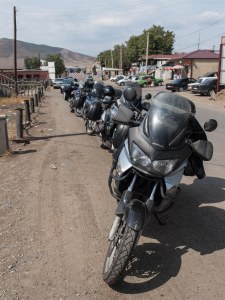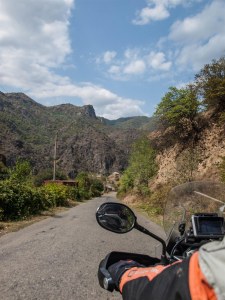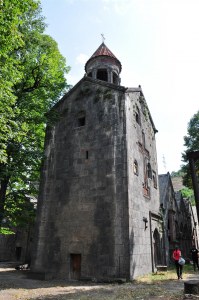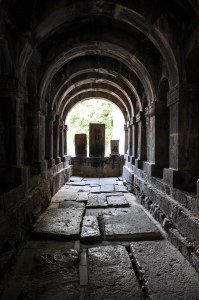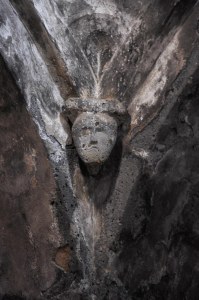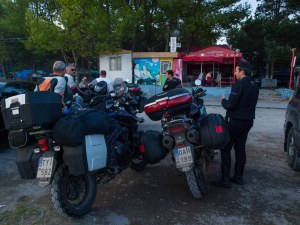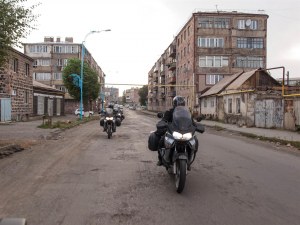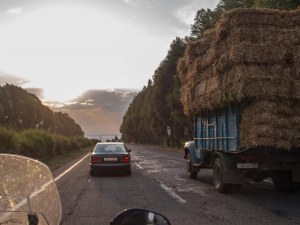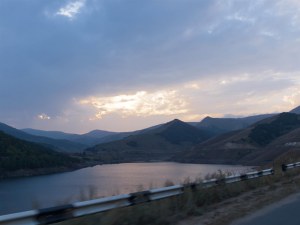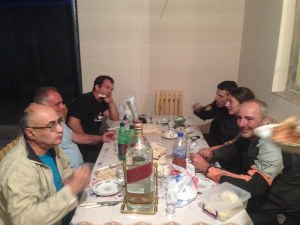The Greek-Armenian hospitality
Morning stretching accompanied today by groans of pain. Just kidding ... but the situation was so tragic, that Stratos chose to pave the substrate on the floor than to sleep on the mattress-fakir. Stretching So breakfast and loading motorcycles to continue south to Armenia. The smell of "unknown" is so strong that makes us look forward to depart.
The road to the border (about 70 km), is relatively good and comfortable. Following the signs to Yerevan - Marneuli - Sadakho, we cross a plain path (about 400-500m altitude) that has something to offer in terms of landscape. Shortly before the village Sadakhlo stop at a gas station to refuel, as we do not know how the situation will be on the payment in Armenian gas stations. Moreover, the price of gasoline has little difference between the two countries. With refueling we do, we will have the autonomy to Yerevan, where you can certainly do exchange.
The border station is the key between the two states. Facilities on new and the process simple and standard. Do not delay us at all, and after a little while longer press on Armenian territory. The first issue that arises relates to motor vehicle insurance in Armenia. We're not sure if you need to issue a security vehicle and -of course- not know its true value. Passing the border check not mention us anything about it, but once we go beyond the limits of the office premises, falling on our "decoys" of insurance companies, exclaiming «Police! Police! ». The starting price is 25 €, but with little haggling the price drops to 15€/bike.
Our doubts about the validity of the policy is to confirm the totally invalid contract completed in time Greek public service, the insurer ... The brand of the bike Stelios mentioned in papers as TRAILMOBILE C71 TOMO1 and the sign is written wrong! Which makes you wish you do not happen and you need to use this document ... To say and skewed the right, however, everyone we asked later in our trip, told us that insurance is necessary. And we asked several ...
We depart for our first kilometers in Armenia. The road conditions are moderate, particularly in the first kilometers after the border. The asphalt is old and the road has some patches, but without potholes. The driving of the locals are clearly better than that of neighboring Georgia. Drivers are generally more predictable and know how to trample and brake. Regarding the route, until the city Vanadzor, for the most part crosses the Debed canyon and the road is parallel to the homonymous rapids. In many places there is thick vegetation and some sources of running water.
The poverty that prevails in the region is immediately perceived. In our passage we find quite abandoned, crumbling factories and many Soviet-style buildings in disrepair. Almost all the houses are stone with roofs of tin and some of them have wood trim on the front with arches and columns are painted in colors such as white, green and blue.
The first attraction for today is the monastery of Haghpat, UNESCO World Heritage Site. It was built around 976AD the queen Khosrovanuysh. In the center of the complex stands the church of the Holy Cross which features unique architecture that impresses for simplicity, while being particularly impressive. Inside has few paintings -as most Armenian churches- while this is known for its impressive fresco of Christ Pantocrator. In this fortified space, there are other buildings such as churches, mausoleums, tombs, library, wine cellars and other facilities.
At the entrance of the monastery we meet a young Armenian, who speaks excellent English. Holder of a Transalp, talks about the beauty of the country, giving us many useful information and his phone in case we need something. Finally invites us to follow him in a two-day trip planned in the coming days, but we refuse politely as we have already booked accommodation in Yerevan in the coming days.
Nearby is another monastery is one of the monuments of cultural heritage of UNESCO, the Sanahin. «Sanahin» in Armenian means "older than the other," that is older than the neighboring Haghpat. The main temple is dedicated to the Saviour and has typical Armenian architecture, austere interior, while a small hole in the ceiling, illuminating the room giving an impressive result. The floor is paved with tombstones, some of which is mentioned and details of the deceased.
Continue to Vanadzor and from there we turn east to Lake Sevan. For some time we are looking for an exchange office or bank, as it is obvious that the use of the credit card is not eligible in this country. But fate zero. So we continue following the mountainous scenic route to the lake and the road begins to rise altitude and the landscape becomes more Alpine. The state of the road is much improved and the poverty of the villages that we find is quite evident. The exception is the town Dilidjan, which is famous for its spa and called by the locals as "Little Switzerland" of Armenia. Unfortunately, neither here find a bank on the main road, so we continue to Sevan.
The route after Dilidjan becomes more impressive, consisting of successive comfortable speed with good road condition. A few kilometers before the lake we leave the main road to lead to the Sevan pass (altitude: 2150m.). The majority of drivers, now uses the new section of highway Dilidjan-Sevan, which has a tunnel which bypasses climbing the mountain. We are moving to an almost deserted route, which offers beautiful views of the surrounding area, while just pass the highest point, the impressive lake Sevan makes its appearance. The lake is the largest of Armenia and loosely resembles sea. At first glance you might not impressed ... but when you consider that it is 10 times larger than the largest Greek lake Trichonida and that is located at an altitude of 1900m., Then things change !!!
Descend to the lake where we pass by the statue Akhtamar, which comes with a nice story. The legend then says that Queen Tamar lived in a small island in the center of the lake and was in love with a "common man" who lived on land. Every night the young man swam in the lake following the light which lit the queen to be found in her arms. The love story ended somehow abruptly, as the father of Queen discovered the secret of love and one evening came and extinguished the candle that Tamar was holding, leaving the young lost in the icy waters of the lake. It is said that even today, in the evenings, one can hear the voices of the young: "Akh, Tamar" (translation Ah Tamar), voices that were blamed for the name of the island in the center of the lake.
We go to the monastery Hayravank which is built on a hill dish lake. Many people go up and down the trail but we admire from afar. Too many churches we have seen today ... This brings us a little further, in the coastal zone where the area is full of tourism. We read that the lake and especially the area around the town of Sevan is the largest tourist summer resort of the country. But the image that we see is daunting.
Makeshift huts which have been converted into outdoor canteen, music blaring and although quite early most people are blind drunk. Several containers have been converted into "hotels", while in the lake you can see from floating restaurants to self-manufactured bicycles. We still haven't found exchange and after tweak that have left over in our travel bags, we ask a taxi driver where can we find cash machine. Note: Bankomat, even an international useful word. He sends us to the neighboring Sevan...
The Sevan is no different from the little villages we have met so far. Soviet buildings packed with the satellite antenna, bad roads -the most dirt roads - many garbage... We ask 2-3 times even ultimately find the bank. Stratos is taking aptly notes that he had time to keep that kind of money in his hands, as the exchange rate is 1€ for 520 Dram. Before leaving, however, we must decide what we would do next, as the sun is starting to fall. There are two possibilities: either we stay in an accommodation near the lake, or will continue for about 60 km to the Greek village Hankavan. Dimitris, Anthony and Kyriakos who had spent a few days before these parties had visited and had met some Greeks who lived there and were told the best. Because of the time we worry as we reach the village slowly and not find anyone should do other 60km to go back plus some time to find accommodation. For a few minutes waver between two possible scenarios... Possibly catalyst was the question that fell in the company: "Logic says to stay somewhere here, the adventure tells you to go to the village." Not to answer, we wear our helmets and we set sail for the Greek village.
Initially we enter for a few kilometers on the highway that connects Lake Sevan with the capital, Yerevan. Then leave the national to climb once again in the mountains. What mountains say that we are already at 2000m altitude. The road is in good condition, without movement along the bed of a river. The scenery is beautiful, and the light of the setting sun gives a special charm.
As we approach the anxiety -for progression culminates day;... We do not know if we will be able to meet some of the people who had known the guys a few days ago. We only know the name of a grandmother of Mrs. Natalia. Finally we reach the village and cross slowly, until the houses end and we have not met a single man! We decide, therefore, to even take a walk and stop for a while to the point that appeared as the most central. There was something that looked like a public building which is anathema, and if we could figure out what it was. So it happened...
We stop looking at each other and we create scenarios for what to do from here. It does not anticipate complete them because of a steep alley heard a voice: "Aristo, the guys are coming! Wait a minute guys I'm going down... " In five minutes appears Vladimir. He wlcomes us by inviting us to go to a nearby house. Up to park our motorcycles Aristos came with Leo, who is Armenian and has married a cousin of Vladimir -as we learned later. We sit in the backyard and before we know the table has been laid to "picking at" up to go to eat normally! Of course the drink is not missing, as the first thing Cairns us is the local liquor of pear, which have made themselves and serve it from a 5 liter bottle! All of us understand what is about to follow... Without knowing what exactly...
Aristos and Vladimir are Greeks who were born and have grown up in Armenia. Their families are now in Greece and they are a few months a year in the village to maintain their homes ... Maybe this is just the excuse, as they love their land and in the back of their minds they want some time to come back here permanently . They have much appetite for conversation and good mood. Without escorts, chicken, sausage, local cheese and bread and of course raki us explain some things about their village.
So, as we were told, was founded about 1830, on the occasion of the gold mine operated by the French away from the location of the village. Some Pontic Greeks had come to the area to work and -while originally lived in makeshift houses-, then with the money they earned working in the mine, created the village, which had around 120 houses. It was only then the Greeks, so they built a church, St. George, with a basilica type architecture without a dome.
With the unrest made in 1960, the French abandoned -for a while- mine while some residents began to leave. Since then began a gradual abandonment of the village. The houses either bought Armenians -that's why they still excist- or simply inhabited by Armenians without purchased (with permission from the owner) without making any special maintenance, apart from the need to avoid collapse. Unfortunately, the rest left uninhabited, slowly became prey to the natural phenomena and to crumble...
The Greeks continued to occupy the village -either as residents, or as casual as families of most living and working in Greece-, trying to maintain the homes of their ancestors and to give life to the place, so as not to become a ghost village. They also try to convey to their children the need to maintain the Greek community in the village which now inhabited for the most part by Armenians.
The village is located at 2300m altitude and is situated between the mountains, so it is not exposed to air. This helps in the period of snow, so as not prevailing frost and be as gentle as possible living. The vegetation is alpine and in some places in the mountains-just above the chorio- are forests.
The church of St. George has no priest. The 85chroni Mama Natalia has the keys and opens to visitors when they request it. Next to the church is the Greek cemetery, while the village is known for its thermal springs which visited several Armenians.
We sit about an hour talking until Vladimir tells us we should be moved to another house where we have prepared food ... as if all this time we ate there! We take motorcycles with our things and after doing any 500 to park in the inner courtyard of a two-story house. We go down to the place that dinner table has prepared and meet the owner of the house, Karen who is not Armenian and doesn't speak Greek.
Karen was a professional dancer and choreographer and Greeks liken him to famous greek dancer Metaxopoulos. He was famous in the country, but unfortunately not succeeded because of the war in Nagorno-Karabakh. He fought there for some time and had an accident in his hand. When he returned from the war, things had changed his life, both professionally and socially. Some friends had been killed and some avoid him already. As expected his career on the professional dance had changed ... So he went back to the village and made his home in a hostel style, for those who come for the spa.
So we sit down to eat and after the necessary recommendations, starts the "second round of drinks." The Armenians have a custom, or rather more a "habit" when drinking: before every crack glasses make a toast, which can involve anything. Many toasts were made: for this reunion for the Armenian-Greek friendship, for ties between peoples, for the living, the dead, and sometimes the situation was getting out of control, with toasts for wars and enemies, especially when bottles tend to empty. Of course all the toasts were made in Armenian and Vladimir catch a big force, making nonstop translator!
The evening continues with dancing, as Karen has managed to equip the space with sound system. Indeed he had placed a "disco ball" as an extra detail of the whole scene. With a little drink above we started to dance Armenian melodies with the first dance of Karen, who incredibly appreciates the fact that we try to dance songs of his country! In some cases dancing solo, which makes it very rare, as says Vladimir!
The evening continues until late ... The guesthouse Karen will be our accommodation, but before collapse our host insisted we go to the Spa. We can not deny it and later we can swim in the warm waters of the springs. Indeed, Karen has managed to have at our disposal the best "pool" of plants! Somehow so ends the first day in Armenia. A truly unique experience that will remain etched in our hearts! As many "THANK YOU" can to all those people of Hankavan, is not enough ... These people made a sacrifice for us!


